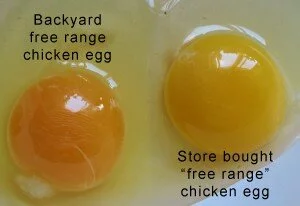You, like me, might be scarred from the horrid pictures of factory chicken farms, with the rows and rows of caged, sickly looking birds, suffering for the sake of the egg industry. It’s hard to walk into a store and purchase eggs when those images crowd for attention.
Once I decided to boycott factory farmed eggs, I was relieved to eggs with ‘cage-free’ labels on them. A humane solution for the egg buying public? Well, maybe not.
There are a lot of labels being boldly stamped on egg cartons these days— cage-free, free-range, organic, vegetarian, pastured-raised, and those boasting high levels of omega-3. It all seemed pretty confusing. What do all those labels mean?
I went to a chicken lecture by a Ph.D. who consults with people who have chicken questions. This guy is very ‘chicken savvy’ and knows a lot about the poultry business as well. In passing he mentioned that ‘free-range’ eggs aren’t from chickens that are running around outside, living a carefree happy life. It means they’re not locked in a cage like battery chickens (who live in a tiny cage with other hens with personal space about the size of a standard sheet of printer paper). They technically have access to the outdoors (which could just be a tiny concrete slab), but most don’t venture out because of the inability to access the tiny doors leading to that ‘free-range’ freedom.
That lecture made me realize I needed to find out about the chicken egg labeling standards. I wanted to know what all that labeling meant for my choices as a consumer. Right off the bat, I was surprised to find that the US Department of Agriculture pretty much has no standards in this area, largely leaving it open for self-regulation (the exception to this is using the word ‘organic’. Otherwise anyone can use any label they want on their egg packaging).
Keeping in mind that what you read on an egg carton might not be what you get, here are some clarifying definitions to help you navigate your way through the egg section of the grocery store:
Cage-Free Eggs: Cage-free means exactly that. Hens aren’t forced to live in cages but live instead in a big barn or warehouse. While this is a step up from the battery cages, many of the same practices are still used (such as starving a hen at the end of her egg laying capacity to force her to molt so she’ll have one more round of egg laying before she’s disposed of, and debeaking the hens by chopping off part of their beak—and often tongue—without pain killers, to keep them from pecking at each other).
Free-Range Eggs: By definition, free-range hens are required to have access to the great outdoors. Although it seems like another small step in the right direction, it’s not much different from their cage-free cousins because of technicalities. For example, there might be a tiny door somewhere in the hen-house that will allow the hens outside to a small-enclosed dirt patch or concrete pad, but the access is limited and the hens don’t use it very often (or ever) because of how their living arrangements are set up. Also, forced molting and debeaking can be practiced.
Humanely Raised Eggs: This definition goes as far as stating that each hen must be allowed 1.5 square feet of room. Also, the hen-house doors must be large enough to allow more than one chicken at a time through its opening. They don’t practice forced molting, but are still allowed to debeak.
Pastured or Pastured-Raised Eggs: This generally means the hens are raised on an organic diet with no antibiotics. They eat a variety of food because they’re most often raised in a moveable pen so they have access to plants and insects.
Organic Eggs: The only thing that is a for-sure with organic eggs is the hens have been raised on organic feed and they haven’t been given antibiotics. There are no mandatory guidelines for how the chicken is raised or housed. They are generally the tortured caged hens in factory farms, they just eat healthier food.
Vegetarian Fed Eggs: The hens that laid the eggs have been fed a vegetarian feed with no animal protein in it. Again, there are no stipulations made for how the hens are treated or housed, just simply that they eat vegetarian food (chickens, however, are not vegetarians by nature, in case you’re wondering).
Omega-3 Eggs: All chicken eggs contain omega-3, but eggs claiming this label are essentially telling you that they’ve got added flax-seed, linseed or other supplements added to their diets which will boost the omega-3 levels in the eggs. (Again, since nobody is regulating this, how much of these seeds or supplements are being fed to the chickens, and how much higher the levels of omega-3’s in the eggs are in question).
All this information is a bit overwhelming and disheartening, if you ask me. Since I’ve become a chicken owner, I can’t imagine subjecting my hens to crowded conditions, forced molting or debeaking.
Are there any ‘safe eggs’ out there? Well, yes. I have some happy, full-beaked, spoiled chickens. They have daily recess time, eat fresh fruits and vegetables, have a spacious hen-house (it’s even insulated) and chicken run. They dig up worms, chase butterflies and live a very contented life. In return, they each give me several eggs per week.
If you’re not raising your own hens, it’s never too late to start. If a small backyard flock isn’t possible, though, you might be able to buy healthy eggs from neighbors or farmers markets. We might not be able to make sweeping changes in the egg production industry today, but we can be more educated about egg carton labeling while making informed purchases.
PS If you’d like more information about how to raise chickens (and guilt-free eggs), check out the chicken section at the City Girl Farming website or the City Girl Farming Blog.

